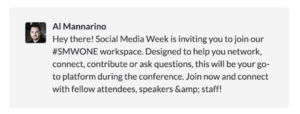The Future of Events: Effective Ways to Engage Your Audience Virtually in the “New Normal”

The first-ever virtual NFL Draft was expected to be “a chaotic mess” — but it went off without a hitch.
Not only did it shatter viewership records, drawing a total of 55 million people, but it also saw a double-digit percent increase in overall ad spend compared to last year. NFL Commissioner Roger Goodell was so pleased with the outcome that he plans to incorporate virtual elements to future in-person drafts.
Yes, sports fans have been stuck inside for weeks and there’s no NBA, MLB, or NHL to watch instead. But the Draft still helped demonstrate that virtual events, even on a large scale, can be successful — and that’s good news.
A recent survey showed that the notion of attending a major public event — even after public health officials have said it’s safe — will scare 47% of U.S. consumers “for a long time.” Half of respondents said it will take “a few months” to “possibly never” for them to return to such venues.
That means that anyone whose old way of doing business included large-scale events will need to think differently — whether offering virtual experiences in the short term or adding virtual elements to in-person gatherings in the future.
Here’s what we’ve learned from major events and conferences that have gone virtual this year:
- People want to connect, and you’ll need to help them.
Events allow people to connect over common interests, and that’s a big reason we attend them in the first place. To get people to dial in remotely, it’s important to prioritize strategies that will help virtual attendees do the same.The popular Social Media Week conference — which normally draws 75,000 attendees across 24 cities — developed ways to navigate this as it pivoted to a single, month-long, virtual conference this year. A week before the conference, attendees, speakers, and staff were given access to a Slack channel to start making connections. As the event began, participants were able to build on these connections through video hangouts and breakout sessions. Another strategic move? Some people who had already purchased tickets got a complimentary virtual ticket to share with a friend to help break the ice.
- Encourage high-profile participants to show some personality.
Part of what made the virtual NFL Draft so enjoyable was getting an authentic look at coaches, managers, and owners in their own homes. Whether seeing a coach’s relatable love of dogs, not-so-relatable access to yachts, or sense of humor that allowed his family to have fun with the remote access, these never-before-seen elements earned a lot of online chatter among fans and media alike.
Rather than insiders-only experiencing on-the-ground moments, fans across the country got exclusive access to what these professionals are like in real life. When hosting a virtual event, think about how you can offer a look behind the curtains at your high-profile participants. It can humanize celebrities, CEOs, or other influencers in ways that can’t be accomplished in person.
- Think beyond a “host city” audience and reach out to that influencer who is never available.
Hosting a fully or partially-virtual event allows you to engage with a broader audience. It also widens the opportunity to find stories that directly serve the message you want to lift and seamlessly integrate influencers who might otherwise have scheduling conflicts.One World: Together at Home — a virtual concert hosted by Global Citizen to activate people in the fight against coronavirus — showcased stories from doctors, nurses, and families around the globe and featured an international group of performers. This helped demonstrate the widespread impact of the virus, fostered a sense of solidarity, and drew in viewers of all different ages and locations. Most events won’t focus on a topic that’s as top-of-mind as coronavirus is right now, but this same tactic can build and strengthen any community by highlighting unknown connections between people around the country or world. - Don’t forget to test your tech and train your participants.
Even in 2020, people need help with tech. While we’re all getting better at video conferencing (Zoom backgrounds can be a real struggle!), pulling off a large scale event requires even more prep.To get the final Draft product you saw on ESPN, the NFL sent 100 at-home production kits to prospects, coaches, and GMs, including two iPhones, tripods, microphones, a lighting kit, and noise canceling headphones. Less than a week before the draft went live, they held a mock draft to test it all out… and it’s a good thing they did because it didn’t go well.
By identifying all of the issues — from user error to tech limitations — they were able to work out the kinks in time for the real thing.No matter the scale of your event, it’s important to prep your hosts and talent with toolkits on everything from how to use the tech platform you’ve chosen to tips on how to record the best selfie video when all you have is your own smartphone at home. Doing so will level up your production quality, no matter what you’re working with.
- Plan for what your audience needs now and be prepared to make changes.
A critical element of future events is planning with the current consumer reality in mind and being prepared for any issue that might arise. The NCAA lost nearly 80% of its annual revenue when it canceled March Madness. The city of Austin, TX, lost an estimated $350 million when the SXSW festival shut down.As long people remain wary of large gatherings, organizers must think about virtual elements for their events to protect themselves and the general public.When social distancing measures ease and people start gathering for events once again, there will be no excuse for not having a postponement or cancelation policy and plan. Health and safety protocols must be readily available for your in-person audience. Your team needs to be prepared to communicate in the event of a crisis. As we’ve all learned, life can be unpredictable and organizers need to be flexible planning events moving forward.